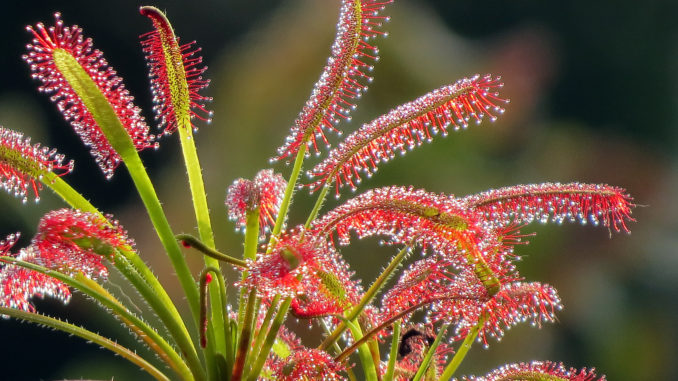

Bryan Fischer | Gardens on Spring Creek
As temperatures grow cooler and nights grow longer, many of us turn to houseplants as a reprieve from the bleak browns of a Colorado winter. This season, instead of heading to the nursery for another foliage plant, consider branching out into growing something a bit more appropriate for the season: a carnivore!
Not just the ubiquitous Venus flytrap, carnivorous plants encompass a diverse and quirky group of plants originating in areas with soil or water low in concentrations of essential nutrients. While they still photosynthesize to produce their energy, they use insects to supplement their limited nutrient spread provided by the relatively nutrient-poor soils or water in which they grow. A number of these plants can be grown more easily than one would expect in the home. What’s more: these plants can be purchased online and shipped to your door for surprisingly reasonable prices.
Among the easiest for home culture, topical (especially those of South African origin) Drosera species make ideal starter carnivorous plants. If potted in a media of half peat and half perlite, they will grow with relative ease in dappled light indoors. Many of these sundews, like cape sundew from South Africa (D. capensis), don’t require any major change in culture throughout the year. This trait makes them better houseplants than some other carnivores; such plants from areas with cold winters, including the Venus flytrap, generally require a chilling period that can be impractical to replicate in the home.
The easier-to-cultivate Drosera grow steadily with consistent moisture, light, and temperature. A spread of leaf shapes, colors, and sizes produced by cultivars of these plants, ranging from cute, round, and green to almost alien-looking, tentacle-like, red leaves provide a surprising amount of year-round interest. Their leaves are covered in colored hairs, each with a glistening bead of baited, enzymatic juice at its end, ready for an unsuspecting bit of bug-brained fare—talk about a two for one! Pest management and some solid botanical novelty all wrapped into one.
Another favorite carnivorous plant of mine for home culture, Utricularia sandersonii has exceeded all my expectations. Despite its horrid common name (Sanderson’s bladderwort), the plant is downright adorable, creating a mat of tiny, chartreuse leaves followed by liberal production of flowers that look like pairs of lavender-colored bunny ears bobbing atop threadlike stems. Mine grew almost effortlessly in the living sphagnum moss that it came shipped with after I placed it in the bottom of a small glass vase. All it required of me was a sunny windowsill and regular watering.
For information on growing other carnivores, including butterworts (Pinguicula spp. and CVS.), which double as succulents (could this be the millennial’s dream houseplant?), consider checking out the Gardens’ blog at gardensonspringcreek.blogspot.com. Whatever carnivorous plant you may choose to grow, be sure to use very pure water for your waterings. Growing in such places as bogs and mountainsides, most carnivores have a very low tolerance for dissolved nutrients and salts in their water supply. Regular watering with tap water in most parts of the country can reduce vigor or kill these plants over time. While fine to use in a pinch here and there, most waterings should be with either rainwater/snowmelt or filtered/distilled water.
Support Northern Colorado Journalism
Show your support for North Forty News by helping us produce more content. It's a kind and simple gesture that will help us continue to bring more content to you.
BONUS - Donors get a link in their receipt to sign up for our once-per-week instant text messaging alert. Get your e-copy of North Forty News the moment it is released!
Click to Donate
